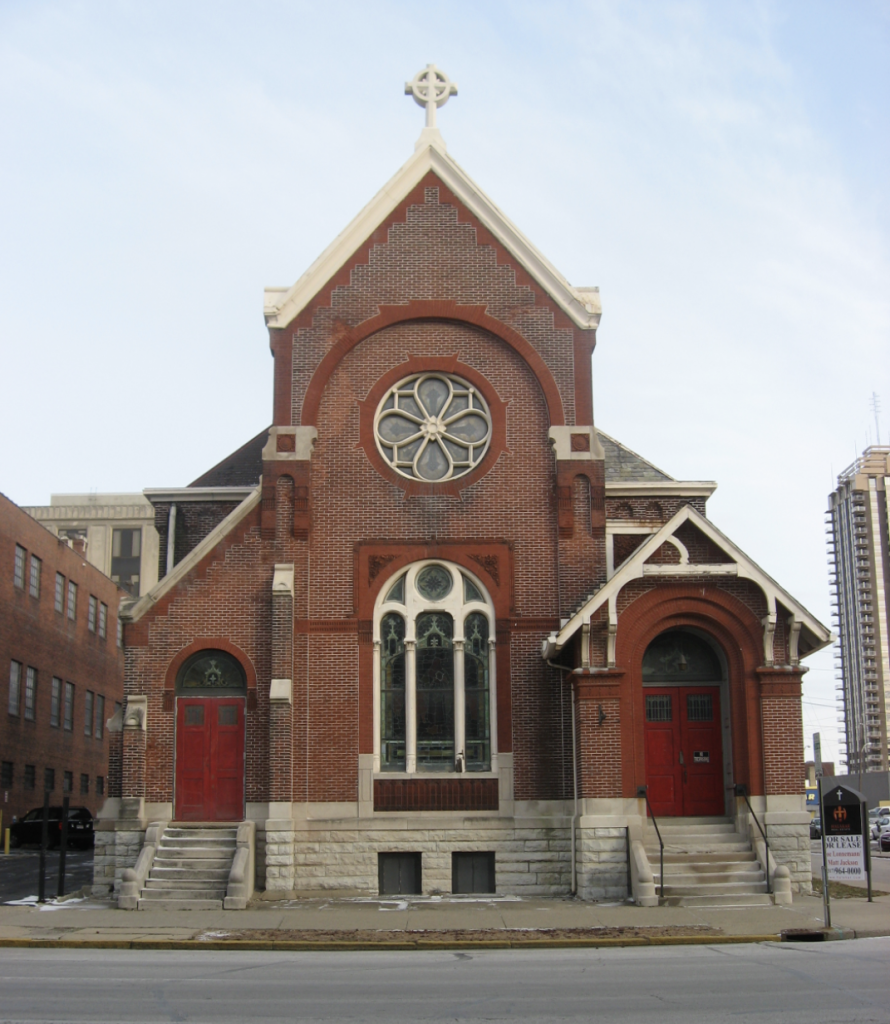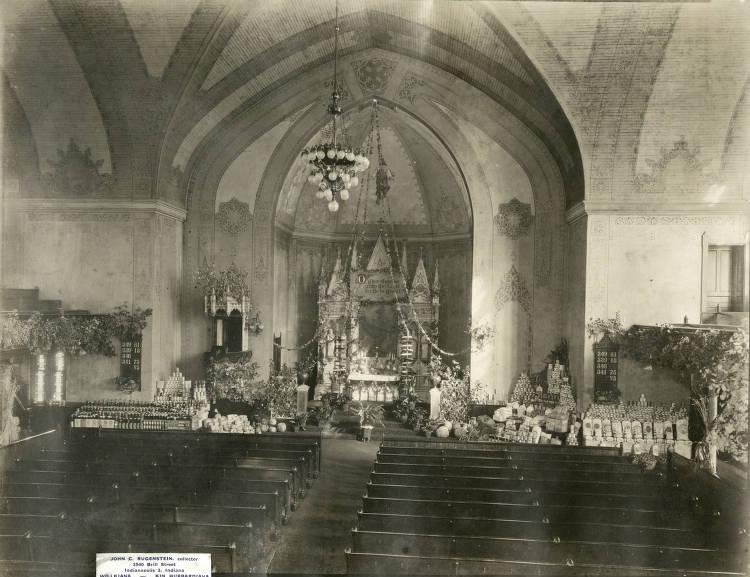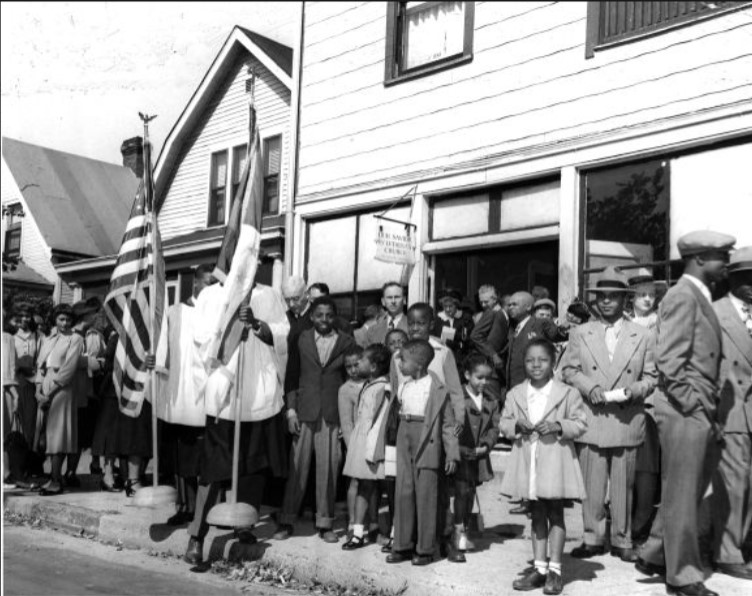Although Lutherans from Maryland settled in Marion County around 1830, the first Lutheran churches did not appear until 1836 when Pastor Abraham Reck arrived in the vicinity and organized Ebenezer Luthran Church on the Millersville Road and Hopeful Evangelical Lutheran Church (now Salem Lutheran) at New Augusta. A year later the earliest Lutheran church organized in the city itself was constituted when the heads of 20 Lutheran families residing in Indianapolis became charter members of Mt. Pisgah (now First Lutheran).

The Lutheranism over which Pastor Reck presided was not that of the state churches of Northern Europe, however, for Reck had come to terms with denominationalism. He advocated the “new measures” being employed by Baptist, Methodist, and Presbyterian revivalists to attract church members, and he functioned as a sort of religious entrepreneur, organizing and serving as many as six congregations simultaneously. Liberal in doctrine and liturgical practices. Reek’s Indianapolis area congregations initially affiliated with the Synod of the West. This supervisory judicatory was connected, in turn, to the General Synod, a body that, in its acceptance of other forms of Protestantism, was more comparable to other denominational structures in the new nation than other more conservative Lutheran synods.
In 1844 an English congregation made up of pioneers from Maryland and Pennsylvania established Pleasant View under the guidance of Jacob Scherer, who also pastored the Mt. Pisgah and Ebenezer churches after Abraham Reck left the Indianapolis area. These three churches were among those represented two years later in a meeting at First Lutheran that formed an Indiana judicatory, the Olive Branch Synod, in Indianapolis.
In Europe Lutheranism existed as part of an establishment that integrated church and state. Not surprisingly, therefore, the Lutheranism that appealed to recently arrived immigrants reflected the European pattern of an official church rather than simply one of several denominations. But the European pattern was by no means uncomplicated. In some states Lutheran and Reformed churches were brought together in the same establishment while in others confessional Lutheranism held fast to the historic Lutheran doctrines—the “real presence,” for example —and such traditional practices as catechizing Lutheran children.
The sequence of church formation in the decades following the organization of the initial Lutheran congregations in the area reveals that the larger trends in Lutheranism in America were played out in the Indianapolis area. The diversity within American Lutheranism created complications for local churches. Early in the 1840s a second Lutheran pastor, Theodore J. G. Kunz, came to Indianapolis and attempted to organize a single parish composed of adherents of both the German State Church (which brought Lutheran and Reformed congregations together in a single body) and Confessional Lutherans. Although his effort at amalgamation was unsuccessful, the church Pastor Kunz organized in 1841 gave rise to two important Indianapolis churches, Evangelical German Zion’s Church, which eventually became Zion Evangelical, and St. Paul German Evangelical Lutheran Church, which at one time was the largest Lutheran congregation in the city. Each of these congregations affiliated with a different synod: in 1862 Zion’s Church joined the Western Synod, which included Reformed as well as Lutheran churches in the Midwest, while in 1847 St. Paul’s affiliated with the Missouri Synod, which held to a strict Lutheran confessionalism.

The arrival in the city of increasing numbers of immigrants from Germany and other parts of northern Europe complicated the relationship of local Lutheran bodies to the various synods and to each other. While certain congregations such as St. John’s developed independently others were assisted by existing congregations. Indeed, if German Lutheran churches were not as comfortable with denominational status as other Protestant churches in the area, especially as far as the use of revivalistic techniques for building church membership was concerned, their history shows that the practice of church planting functioned as an alternative procedure for spreading the Christian gospel. St. Paul’s, for instance, grew so rapidly that it became the mother church to Trinity Lutheran in 1872 and Trinity, in turn, directly contributed to the founding of St. Peter Lutheran in 1896. Emmaus Lutheran organized in 1904 was also a daughter church to St. Paul’s. The city’s Danish immigrants initially worshipped at St. Paul’s. In 1869, however, they organized their own congregation, First Trinity Danish Lutheran Church.
Outside the German community, congregations were often organized at the behest of one of the various Lutheran synods. A notable effort of the Olive Branch Synod was founding Saint Mark Lutheran in 1891. At the turn of the century the city had no Lutheran church representing the Evangelical Lutheran Joint Synod of Ohio; in 1908 the Western district of the Synod worked for the founding of St. Matthew Lutheran Church. Nearly a half century later, this congregation sponsored both Faith Lutheran Church and Hope Lutheran Church. Bethany Lutheran resulted from a canvass made by a group of men from St. Mark’s; Bethlehem, first named Reformation Lutheran Church, came into being following a canvass by the men of First Lutheran Church. One hundred and twenty laymen of the Federation of the Missouri Synod Lutheran Churches made house calls in several areas of the south side of Indianapolis. Calvary Lutheran Church was founded in November of 1929 as a result of such efforts. What is clear here is the existence of what might be called a mission pattern. While the Great Depression hindered the construction of churches, it did not entirely impede the mission impulse: In 1938 the YWCA was pressed into service for the establishment of a “Negro Mission,” providing the genesis of a bond that would grow between Caucasian Lutherans and African Americans.

Seeking to start new congregations was but one example of the service mission of Indianapolis Lutherans. The was founded in 1883 by members of the Bible Society from St. Paul’s and Trinity Lutheran. Dedicated as “an asylum for orphans and aged people,” the first orphanage housed three orphan children, foster parents, and support staff. During their first decade both St. Paul’s and Zion’s churches established parochial schools which served their immigrant members well as they settled into the Indianapolis scene. Attention to education and social service continued throughout the 19th century and remains critically important to Indianapolis Lutheran churches. In 1922 the Lutheran churches affiliated with the Missouri Synod organized as a federation to encourage support of the Haughville Mission (which became Grace Lutheran) and cooperation in educational and social services. The Federation of Lutheran Churches of Greater Indianapolis gave rise to an association for parochial education at the secondary level and this association began operating the Lutheran High School of Indianapolis in 1976.
During the 1970s and 1980s, merger talks between the Lutheran Church of America (LCA), the American Lutheran Church (ALC), and the Lutheran Church-Missouri Synod took place. When the latter opted out of the discussion, more than 100 former Missouri Synod churches organized the American Evangelical Lutheran Church (AELC). The AELC provided support for two Indianapolis Lutheran congregations, Our Redeemer and Pilgrim Lutheran, thereby continuing the mission emphasis of Indianapolis Lutheranism.
Carrying on in the ecumenical spirit of the Lutheran church, the AELC joined in a dialogue between the LCA and the ALC which resulted in the formation of the Evangelical Lutheran Church in America (ELCA) in 1988. The Indiana-Kentucky former Synod of the Lutheran Church in America became the Indiana-Kentucky Synod of the ELCA, whose offices are in Indianapolis. Although more liberal than the Wisconsin and Missouri synods, the ELCA is attractive for those who want to maintain a tie with historic Lutheranism.
A record of a European church that became an American denomination without losing its character as the religion of a particular people, the history of Lutheranism in Indianapolis provides a picture of a very different form of American Protestantism.
*Note: This entry is from the original print edition of the Encyclopedia of Indianapolis (1994). We are currently seeking an individual with knowledge of this topic to update this entry.

Help improve this entry
Contribute information, offer corrections, suggest images.
You can also recommend new entries related to this topic.